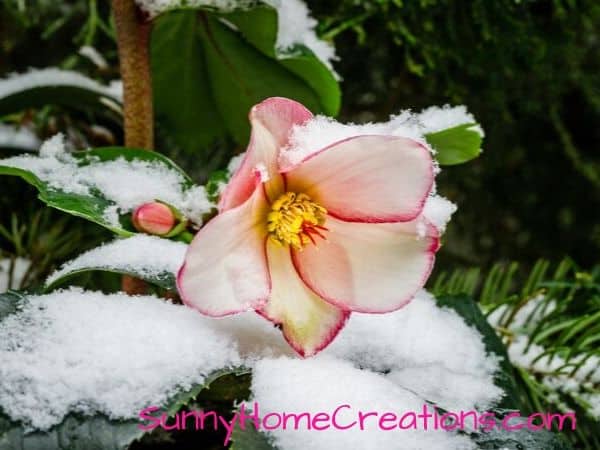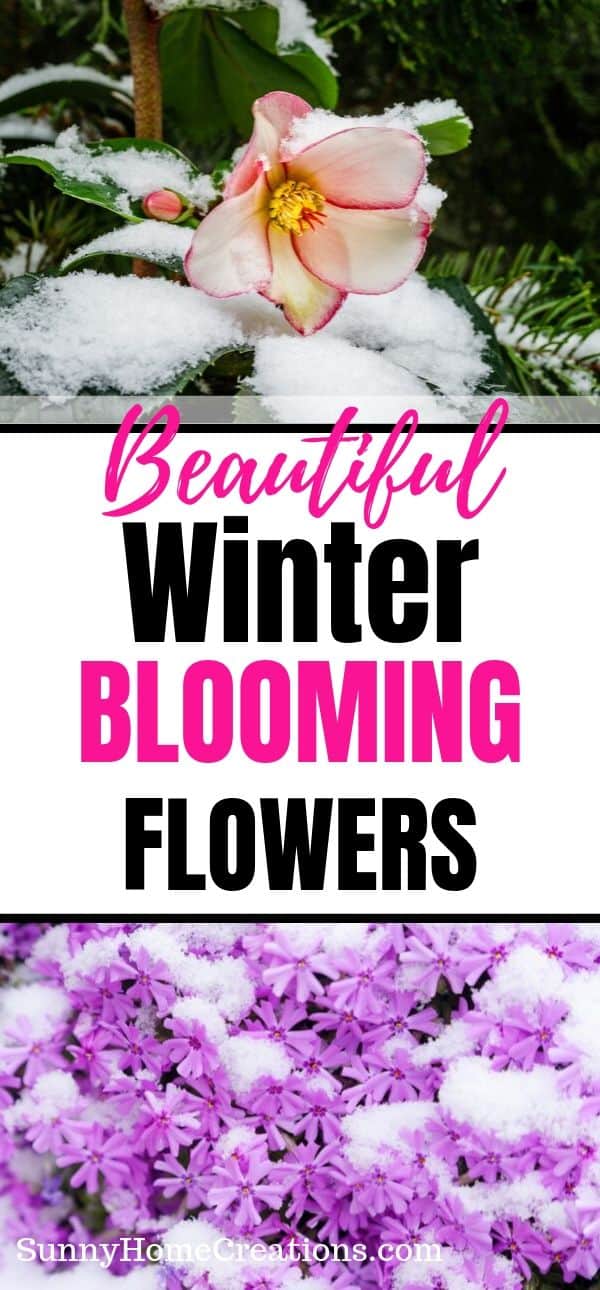This post may have affiliate links. If you click one of these links and make a purchase, we will be paid a commission at no additional cost to you.
Do you feel sad about your garden as the last of the summer blooms fade away? Maintaining a colorful garden can be quite a challenge especially during the winter, but it is not impossible.
You can still find ways you can surround yourself and your garden with beautiful blooming flowers during the colder months of the year. Let’s look at some of the flowers you may want to add to your winter garden and some tips on how to maintain them.
Winter Blooming Flowers
English Primrose

Although a lot of primrose varieties bloom during spring, the English Primrose is a perfect addition to your winter garden.
The English Primrose comes in many different colors and can add a pop of color to your garden. It can make the yard feel a bit warmer and sunnier even if the weather is cold and miserable.
Winter Jasmine

The winter jasmine can bloom during winter and can even withstand the snow.
Compared to other jasmine varieties, the Winter Jasmine comes unscented — but still has the same, beautiful colors.
Hellebore

There is a reason why the Hellebore is also called the Christmas Rose: It blooms during the darkest and coldest months of the year.
The Hellebore has a deep growing root system, which protects it from the harsh weather and strong wind. You can plant them during the early winter and they will be in full bloom during the late winter.
Sweet Alyssum

The cold weather is not a problem for the dainty flowers of a Sweet Alyssum.
Other than giving life to your garden during winter, many, many years ago this plant was used for animal bites and to cure rabies. They are easy to grow, whether you are starting them from seed or plants. Plus, they give off a subtle, sweet scent once in full bloom.
Winter Honeysuckle

If you are looking for a winter flower that gives the best scent, plant a Winter Flowering Honeysuckle.
Though this plant will fill your garden with creamy white flowers and a beautiful scent, they can become invasive.
Phlox

There are a lot of colors for Phlox: They come in bright pink, white, crimson, and dark purple.
Phlox bloom all-season long and can survive even with partial sunlight.
Honeywort

Honeywort is a good addition to any winter garden. The colder the weather is, the more color you can see on a Honeywort.
The leaves turn to a deeper blue shade once the weather drops.
These flowers are known as hardy annuals and grow best during winter. They can grow in most soils and require full sun to light shade.
Tips For Growing Winter Bloomers
Preparing Your Winter Garden
Before you plant any flowers in your garden, it’s a must to prepare the bed.
Limit applying fertilizer to the soil when you prepare it for winter. You can use ground and composted fertilizer or manure that provides a well-balanced supply of nutrients to the plants.
Spread a new layer of mulch. Spread a thicker layer than what you typically apply during spring and summer to help protect the soil during the winter.
Planting In Pots

It may not be ideal to plant in your garden beds, especially if the ground is too cold.
Instead of planting in the ground, you can choose to pot your flowers instead.
Fill your chosen pot or container most of the way with a moist, high-quality potting mix. Before you place the flowers in, create a shallow hole at least 1 to 2 inches deep and plant.
To avoid overwatering, you can also place pebbles in the bottom before adding the potting mix.
Shed Some Light
Flowers need light in order to maintain their health. If you’re keeping the pots indoors, keep them in a bright room to encourage them to bloom.
You might even want to invest a little money in some grow lights that will help them get the light they need.
Promote Adequate Drainage
When planting in pots and containers, make sure that there’s adequate drainage. Without proper drainage, the soil will be waterlogged, resulting in your plants dying.
Choose pots and containers with drainage holes or drill holes in the bottom of the containers.
You can also insert a smaller container inside the bigger pot to catch the extra water.
Keep Them Moist
Your newly planted flowers need to be soaked in water.
Garden flowers need at least 1 to 2 inches of moisture every week in order to bloom and perform well.
It’s best to water your plants deeply but less frequently than shallowly and more often. Flowers in pots need more water as they have less moisture in the soil.
After the plants have become established you can water a little less frequently to make sure that the soil will maintain its moisture but not be overly wet.
Snip Off The Dead Heads
Once your flowers begin to bloom, there are times when you will notice that there are dead flower heads. These flower heads drain the energy from the plant, removing them allows that energy to flow through to the new growth of the plant.
Clip off the dead flower heads to encourage the plant to put more energy into the foliage. Most flowers bloom again even after you cut off the dead blooms and often more frequently.
Supply Food
When preparing the soil for your flowers, you’ll need to add fertilizer. You should also add fertilizer when they are in bloom as well, to make sure that they have a good supply of nutrients.
Use an organic plant fertilizer. Fertilizers with chemicals can burn the flowers and might lead to weak plants and yellow leaves. You can also feed the plants a slow-release fertilizer.
Mulch. Mulch. Mulch.
Mulching can help conserve the water in the soil. It can also help the soil maintain its temperature and prevent weeds.
When applying mulch, you can use bark chips, grass clippings, pine needles, shredded leaves, and compost.
Apply 2 to 3 inches of organic mulch around the flowers after planting. You can also spread 2 to 3 pieces of newspaper around the plant before scattering the mulch. The newspaper will be a barrier to keep the leaves of the flowers from touching the soil.
Watch For Pests
Even during the winter, your plants can still attract pests.
Insect damage can affect more than the appearance of your plants. Bacteria and virus can enter the plant from the damage made by the insects.
Once a plant is affected, the virus can spread from one plant to the other. Plus, it can also cause stress to the plant.
Always check the plants for a possible insect infestation.
You can use an organic spray to remove insects from your plants.
You can mix 2 tablespoons mild soap with a gallon of water. Spray the mixture onto the plant.
Or
Add 2 tablespoons mild soap and 2 tablespoons of Neem oil with a gallon of water. Mix them together and spray onto the affected plant.
Avoid Overcrowding
When planting in flower beds, make sure to provide adequate spacing between the plants.
Crowded plants create their own humidity. This will allow common diseases like downy mildew, and powdery mildew from spreading around.
You can improve airflow by placing enough space in between the plants.
Plus, placing the plants too closely promotes competition for water, nutrients, and light resulting in poor plant health.
Add color to your winter garden by planting blooming flowers. Use these tips to ensure that you can grow healthy plants even in the colder months of the year.






Leave a Reply